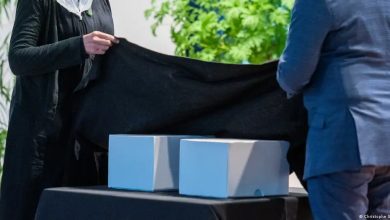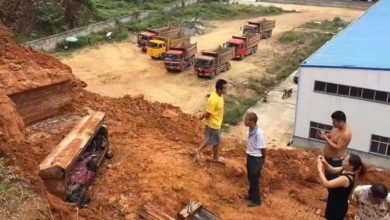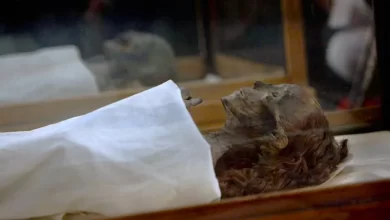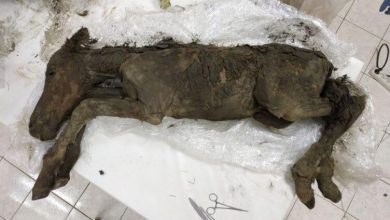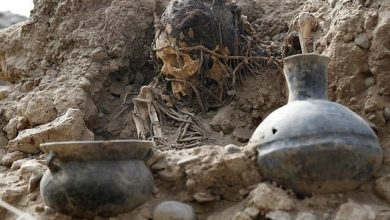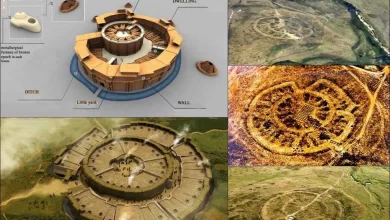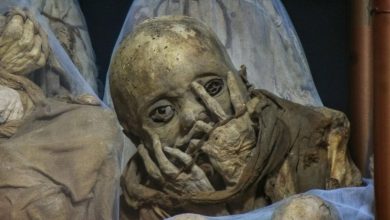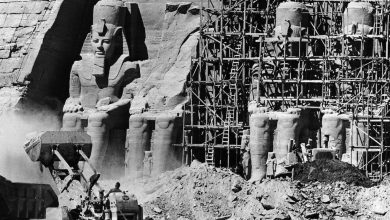Archaeology breakthrough as 1,200-year-old mummy found in underground tomb ‘bound by rope’.

The desiccated remains were unearthed at the archaeological site of Cajamarquilla, just 16 miles east of Peru’s capital, Lima. According to experts from the National University of San Marcos, the mummy dates back to between 800 and 1,200 years ago, though little is known about the circumstances of its burials. The archaeologists hope radiocarbon dating will help narrow down the mummy’s exact age.
More bizarrely, however, is the fashion in which the mummy was buried.
The mummy was discovered in a tomb with its limbs tightly bound with rope and the hands were placed over the face.
Lead excavator, Pieter Van Dalen Luna at the California State University San Marcos, claimed this would have been a funerary practice of a pre-Inca civilisation that occupied the region.
He said: “The main characteristic of the mummy is that the whole body was tied up by ropes and with the hands covering the face.

The mysterious mummy was found by archaeologists in Peru (Image: UNIVERSIDAD NACIONAL MAYOR DE SAN MARCO FACEBOOK )

The experts have not identfied the mummy’s sex (Image: UNIVERSIDAD NACIONAL MAYOR DE SAN MARCO FACEBOOK )
“Radiocarbon dating will give a more precise chronology.”
In a Facebook post, the Uni of San Marcos said the remains likely belonged to a “resident of the Peruvian highlands”.
The discovery, the University argued, sheds new light on a multi-ethnic region that served as a “strategic place for commercial exchange between the coast and the mountains”.
Alongside the mummy, the archaeologists discovered bits of pottery, stone tools and even trace evidence of vegetables.
The discovery comes just weeks after archaeologists made another chilling discovery at Huaca Santa Rosa de Pucala, some 466 miles north of Lima.

A team of excavators announced the discovery of nearly 30 human remains, including those of three children.
The remains were attributed to the pre-Inca Wari and Mochica cultures and were buried more than 1,000 years ago.
The three children and one teenager were found at the front of a temple, indicating they were human sacrifices.

The remains are between 800 and 1,200-years-old (Image: UNIVERSIDAD NACIONAL MAYOR DE SAN MARCO FACEBOOK )

The mummy was found at a site just 16 miles from the capital (Image: UNIVERSIDAD NACIONAL MAYOR DE SAN MARCO FACEBOOK )
According to the lead investigator, Edgar Bracamonte at the National University of Trujillo, this was the very first discovery linked to the Wari civilisation that was made far outside of their sphere of influence.
The Wari culture flourished in the south-central Andes from about 500 to 1000 AD.
Mr Bracamonte said: “These discoveries allow us to rethink the history of the Lambayeque region, especially the links to Wari and Mochica occupations in the area.”
The remaining 25 remains belonged to the Mochica or Moche culture, which developed in northern Peru between 100 and 700 AD.
The Mochica remains were found in a series of clay tombs and burial chambers inside of a ceremonial temple.
Among the remains, the archaeologists also found pieces of pottery and the remains of llamas, alpacas and guinea pigs.
Peru is perhaps best known for the mighty Inca Empire that dominated a large portion of South America from 1438 to 1533.
The empire eventually collapsed due to disease, war and the growing power of Spanish colonists.

